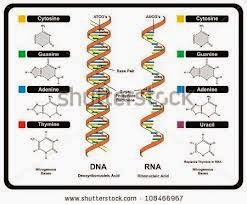First of all, one should determine what classifies as life. Although there is no "standard" model of abiogenesis, multiple hypotheses have shown that life-like processes (such as replication, ingestion of nutrients, evolution and metabolism) could have been displayed/arose through certain chemical reactions. So such processes are as good a place to start as any.
Models
RNA-World Hypothesis
Most people recognize today that the most empirical definition of life is the presence of DNA (deoxyribo-nucleic acid). After all, it encodes our genetic information and contains the essential blue prints of life. But how did DNA come about in the first place? This hypothesis says that the first life would have been RNA (ribo-nucleic acid), which would have served as the basis for DNA. This is because certain proteins are needed to replicate DNA.However, it is DNA that has the genetic information needed to create these proteins. So it becomes a puzzling question of which came first; proteins or DNA? |
| One strand of RNA and one strand of DNA are so similar that they can combine to form a new DNA molecule. |
Most scientists do believe that modern life was descended from an RNA world, but there is still debate as to whether or not RNA-based life was the first type of life to originate.
Deep, Hot Biosphere Hypothesis
This hypothesis states that the earliest life foms didn't form on land, or even at the bottom of the ocean. Raher, they fromed several kilometres underground. It is pretty similar to the iron-sulphor theory in that it predicts life arose from similar chemical reactions (which we'll get to in a second). However, it is still worth mentioning as an underground environment would, ideally, shelter the microbial life from the turmoil of the surface, such as asteroids and radiation.It's believed that whatever organisms formed would have to get their nutrition from a continuous trickle of chemicals from deep within the Earth. However, this energy source would also have to be unreachable. For if it was too easily accessible, it would lead to unsustainable-consumption and the life would eventually be left with no source of nutrition. Possible candidates for this food source could include hydrogen (released from interactions between water and iron compounds), methane in the Earth's mantle and carbon compounds.
Interesting: A controversial prediction of this hypothesis is that oil would be produced as a byproduct of the underground microbes consuming methane. This would imply that oil does NOT come from the surface remains of animals being compressed, as is currently believed, but is actually being continually produced.
Iron-Sulfur Hypothesis
This hypothesis states that life started out on the surface of iron sulfide minerals. This states that the earliest life didn't rely on DNA or RNA for propagation, but rather relied on chemicals from hydrothermal vents on the ocean floor.Hydrothermal vents are important to a group of life known as "chemoautotrophs", which convert inorganic chemicals from hydrothermal vents into organic chemicals (through oxidation reactions) for nutrition. It's thought that perhaps a similar process such as this led to the first replicating chemicals with metabolism-like chemical cycles, which would gradually increase in complexity with more chemicals (a chemical evolution that would later give rise to a biological evolution).
 |
| Water + Carbon Dioxide + Hyfrogen Sulphide = Sugar + Sulphur Compounds |
Clay Hypothesis
A peculiar model, this one states that the original chemicals responsible for information replication would have been silicate crystals. This is as they imitate similar phenomena as living organisms. For example, stickier clays tend to stick to river beds, and the stickier the riverbed, the more likely it is to attract more sticky clays. Therefore, through simple chemistry, clays of the stickier variety are more likely to last by being attracted to other sticky clays through a simple, chemical selection process. A type of "natural selection", if you will. |
| The process of natural selection is also mirrored through clays by the fact that specific clay crystals will attract certain molecules that will make it grow further. |
It's thought that these specific crystals could have then acted as catalysts to eventually create primitive organic molecules, thus paving the way for RNA and DNA.
Other Models
These models, whilst being plausible, are either too complex or too similar to the ones already mentioned above, and thus wold be largely uninteresting to describe in this limited amount of space. They are the:- Zn-World Hypothesis
- PAH-World Hypothesis
- Lipid-World Hypothesis
- Radioactive Beach Hypothesis
Well, that concludes this brief introduction to the field of abiogenesis, a field of ongoing research. In the next article, we'll look at the respective pieces of evidence and difficulties with some of these models.
No comments:
Post a Comment